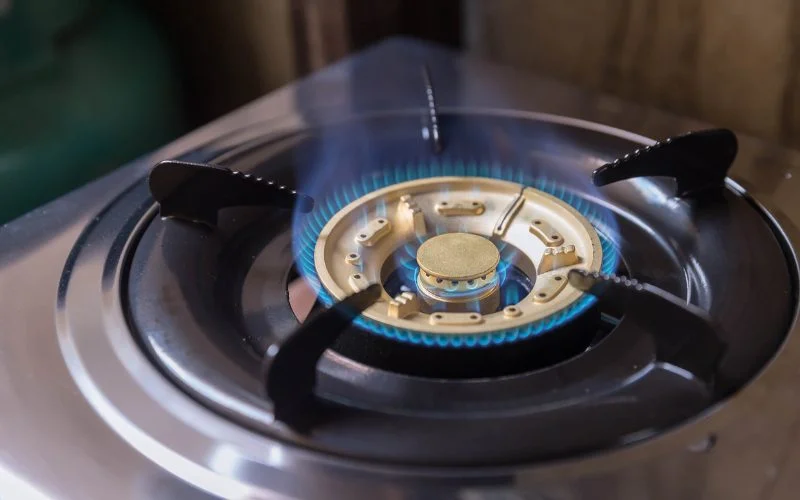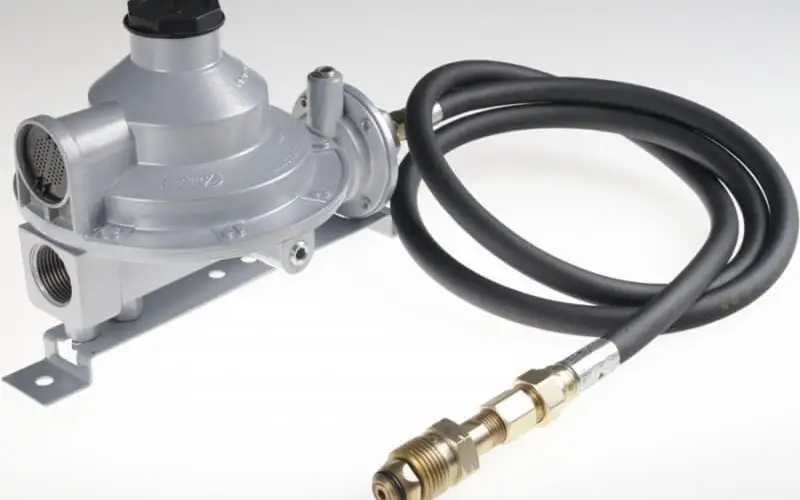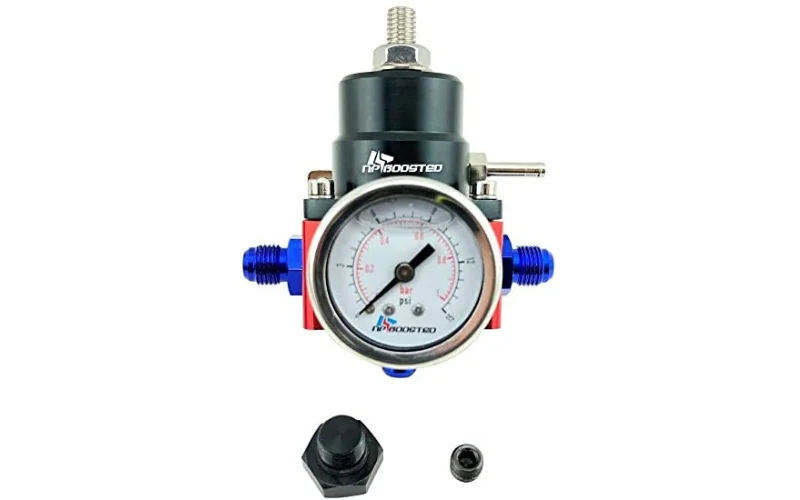Many appliances we use these days for heating our homes and food, from fire pits to gas cookers, use propane. All these appliances come with regulators which control and lower the amount of propane from the tank to the appliances.
The PSI of a low-pressure propane tank is usually around 100 to 200 PSI depending on a few factors, especially temperature, while the regulator’s output pressure is usually less than 1.
Today we will look at low-pressure propane regulators, their function, and the factors that might affect the pressure of a propane appliance.
Understanding The Cooking Gas Propane

When we think of propane as a product, we only see a safe and easy-to-use power source for our household needs like cooking, refrigeration, and heating our home. Still, many processes are involved in making this gas portable, safe and usable.
In its natural state, propane is a gas that can occupy a large volume and quickly vaporize. Still, when it is brought under pressure or becomes s liquid, it makes it easily storable and transportable.
So when propane is pressurized by subjecting it to a temperature of -44 degrees Fahrenheit below its boiling point, it becomes a liquid petroleum gas.
When the temperature increases, propane will begin to boil and then turn into a gas again, which is how we use it in heating. At this point, its pressure is the same as atmospheric pressure. Hence, pressure makes propane gas liquefy and becomes useful for many domestic and industrial uses.
The Use Of Propane Regulators
We have already established that in its natural state, propane is a gas, but when pressure is applied, it condenses into a liquid, and that is how a large amount of power can be stored in a small propane tank. That means that the propane in a tank has very high pressure.
The pressure inside a propane tank or cylinder can is very high. In fact, it has a range of 100 to 200 PSI ( this means Pounds per square inch) and is a measurement of pressure in the Imperial system of measurement, and it is commonly used to measure the pneumatic pressure of gasses).
The PSI value of a propane gas always increases with temperature, like when it is exposed to direct sunlight.
Its liquefied propane gas temperature range is too high for output and hence not suitable for everyday domestic and industrial use since gas appliances require a steady gas glow with a constant pressure level to function safely and correctly. It is where the use of a regulator comes in.
The low-pressure propane regulator and the hose attached to a propane tank or cylinder have one primary function: ensuring proper gas flow to your appliance.
The regulator is engineered to receive gas with a pressure that could even be as high as 250 PSI but allows only a tiny fraction of that enormous pressure to be used by your appliance.
What Is The PSI Of A Low Pressure Propane Regulator?

The function of any propane regulator is to determine the amount of pressure with which the gas leaves the propane tank, and there are different ways of classifying these regulators. Based on the way these regulators function, you can classify them into:
- First stage regulators
- Second stage regulators
- Integral two-stage regulators
- High-pressure regulators
- Adjustable high pressure regulators
- Automatic changeover regulators
How you use the propane gas and the type of appliance you use will determine the type of regulator that you need. For instance, a restaurant that cooks more food requires a propane gas regulator for their burners, unlike a homeowner.
For instance, a propane tank used for industrial purposes will differ from that of a small hand torch.
However, you don’t need to worry about what regulator you will need for your appliance because the appliance manufacturer will indicate it, or even your propane supplier will tell you. For practical purposes, however, propane regulators can be grouped into 2:
- The low pressure regulator
- The high pressure regulator
The Low Pressure Propane Regulator
Most home appliances, be they for indoor or outdoor use like burners, fire bowls, fire pits, and the like, usually use low pressure propane gas regulators.
Each regulator has a given amount of output pressure it allows from the propane tank on average. The PSI of most low pressure propane regulators is about 0.537 PSI. There are others whose pressure can be slightly low, up to 0.4 PSI, while others can be as high as 1 PSI.
On average, most appliances designed to run on propane will need a low pressure propane regulator. Each manufacturer determines how much output pressure the regulator should regulate, and the aim is to ensure that gas consumption is safe.
High Pressure Propane Regulator
Some appliances are designed to be used with high pressure propane regulators. Some crow bangers, high-heat cast iron burners, hand torches, and dehorning cow units are examples of such appliances.
They require high pressure regulators because they need more volume of gas than low pressure regulators.
The pressure these regulators regulate can be anything from 1 to 60 PSI. Some of these regulators have preset pressure, while others are adjustable.
How Temperature Affects The Pressure Of Propane In A Tank
From simple physics, we know that the pressure of gases is directly proportional to their temperature. That means that if the temperature of a gas increases, so will its pressure, and if its temperature reduces, its pressure will follow suit.
So the pressure inside a propane tank fluctuates slightly based on the outside temperature. For instance, if a propane gas has a pressure of 145 PSI at 70 degrees Fahrenheit, but if the temperature rises to 100 degrees Fahrenheit, the pressure will increase to 172 PSI.
So if a propane cylinder is subjected to very high temperatures, like in the case of a fire outbreak, it will cause the gas to expand its gaseous pressure to skyrocket, which can cause the tank to rupture, and this is why gas explosions are disastrous.
In colder temperatures, gases begin to contract, and if the temperature is low enough, they could freeze. It is most unlikely in the case of propane which freezes at -306 degrees Fahrenheit. If you ever notice that your propane gas seems frozen at a shallow temperature, then a tiny amount of water is probably trapped in the cylinder.
Safety Tips For Using And Maintaining Your Propane Tank
1. Always ensure you don’t expose the propane tank to direct sunlight because it can increase the gas pressure in the tank.
2. Remember that dark-colored tanks can absorb more heat than other lighter colors, so ensure that your propane tank is not painted black if you want to maintain the gas pressure of your tank.
3. It is good practice to store your tank in a shaded, well-ventilated area so you can forestall a disaster if the gas pressure rises. It is most unlikely, though, because most propane tanks have a pressure relief valve that ensures the tank’s pressure is relieved if it ever exceeds a threshold.
4. Asides from the fact that damaged and rusty tanks are an eyesore, they can also affect the ability of the gas to maintain the correct pressure.
5. Ensure that no water is trapped inside your propane tank. It is essential because, at shallow temperatures, these water molecules will freeze in the cylinder and might block the nose through which the propane is supposed to flow. When this happens, you will notice that the propane output of your tank will begin to drop.
6. You should keep a spare propane tank and be prepared to make a switch whenever you sense a decrease in the flow of the propane, especially if its output drops drastically due to water in the tank.
7. Ensure that your propane tank is purged of air before filling it, or else the air in the tank will cause the flame to be low for some time before it normalizes. The empty tank is purged of air by filling it with a small amount of gas and then emptying it so that the air is forced out of the tank as you empty it.
8. All propane tanks are now fitted with Overfill Protection Devices (OPD), which ensures that at least 20% space is left in the tank to prevent it from venting large amounts of propane when the ambient temperature rises, as this can cause the flame to go off.
9. It must be ensured that high pressure regulators are not used on low pressure appliances, as this is a safety hazard that leads to damage to the appliance and even a fire outbreak.
Conclusion
Propane is one of the most commonly used heating fuels for cooking and other domestic and industrial purposes. Read also What is a Low Pressure Propane Burner? (What’s the Difference with High Pressure)
You May Also Like:
- Best Propane Fire Pit for Roasting Marshmallow
- How to Start a Fire in A Fire Pit? (With Explainer Video)
- Rick of Wood Dimensions – WHAT IS A RICK OF WOOD?
- Is it Safe To Roast Marshmallows On a Propane Fire Pit?
- How to Get Rid of a Tree Stump With Charcoal
The propane tank stores propane in pressures as high as 200 PSI, but this gaseous pressure is reduced to as small as 0.4 to 1 PSI for output, depending on the manufacturer’s specification, which must be adhered to.
Kindly reach out to people by sharing this post on social media.
If you liked this article, then please follow us on Facebook, Instagram, and Pinterest.

